Through Angelle’s Lens: The Raw Humanity of Music EN/FR
EN
Stepping into Angelle’s world means diving into a space where images become memory, emotion, and truth. From shooting on disposable cameras as a kid to preparing her upcoming project Just Human, she’s carved out a path that’s deeply personal and raw, right at the heart of the music scene. More than just an artistic eye, Angelle brings a quiet, genuine presence, capturing artists in their moments of power and vulnerability. With this upcoming exhibition, photography becomes a space for voices to be heard and stories to be seen, where the spotlight reveals not just the show, but what lies beneath. Meet an artist who’s not just freezing time, but uncovering the human behind the performance.
FR
Plonger dans l’univers d’Angelle, c’est entrer dans un monde où l’image devient mémoire, émotion, témoignage. Depuis ses débuts avec un appareil photo jetable jusqu’à son projet Just Human, elle trace un chemin à la fois intime et viscéral au cœur de la scène musicale. Plus qu’un regard artistique, Angelle offre une véritable présence, attentive et sincère, au plus près des artistes, de leurs instants de grâce comme de leurs fragilités. Avec cette exposition à venir, elle transforme la photographie en espace de parole et de reconnaissance, où la lumière des projecteurs révèle aussi les zones d’ombre. Rencontre avec une artiste qui capte l’essentiel : l’humain derrière la performance.
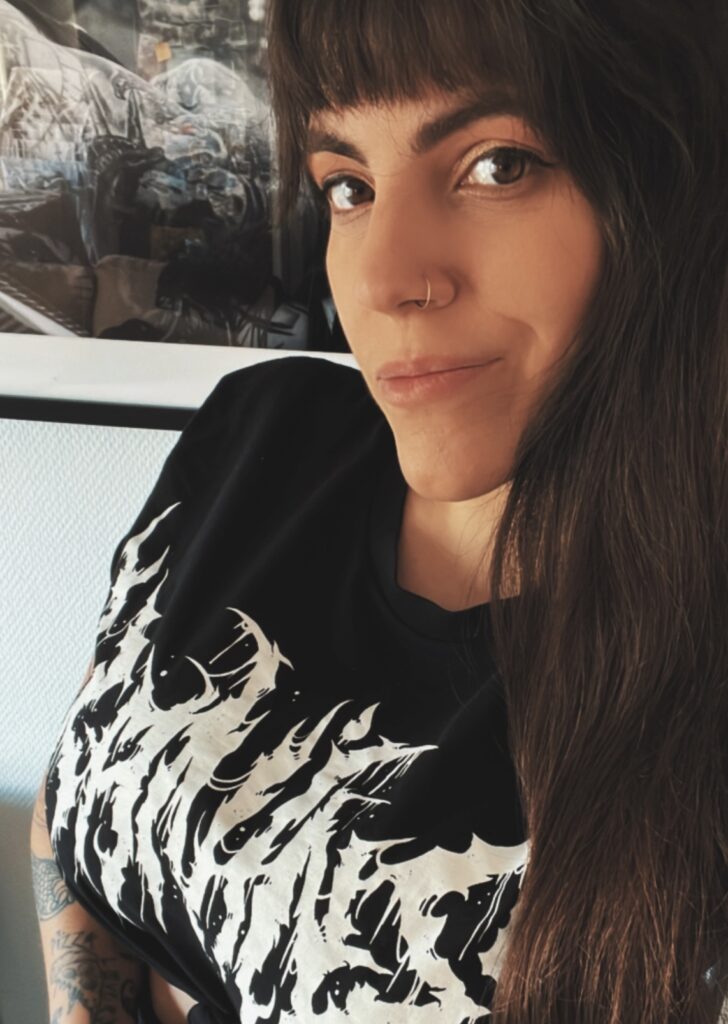
EN
Can you tell us a bit about your journey as a photographer? How did it all start, and what made you want to turn it into a career?
Ever since I was a kid, I always had a camera in my hands, back then, it was those little disposable ones. I used to take pictures of my friends, mostly to keep a trace of those simple but meaningful moments. Then one day, I experienced my first live shows, and it was love at first sight. I wanted to blend the two: living music and capturing its raw energy. At first, it was just a way for me to relive those moments, like a bubble of memories I could go back to. In 2006, I earned a photography certification (CAP) and a high school diploma in photography, and I interned at Buzzer Press. That’s where it really clicked, live photography lit something up in me. The lights, the movement, the raw emotion… I wanted to freeze all of that in time. When I moved to Lyon in 2017, I had to put that part of myself on pause. For a few years, things were tough, personally and creatively. But in 2022, a friend offered me the chance to show my work at his bar. On March 4, 2023, I held my first exhibition, RÉTROSPECTIVE. That was a second spark. Picking up live photography again honestly saved me. Since then, I’ve been continuing on this inner and artistic path. And I felt the urge to build a new exhibition, this time, to shine a light on the people who bring my photos to life: the artists. Their vulnerability, their strength, their presence… I want to honor them through my work.
How has your style and artistic vision evolved since 2006?
In the beginning, my approach was pretty documentary. I tried to capture the overall intensity of a show, the vibe, the lights, the crowd, the stage. It was almost like live reportage, with the goal of showing the full picture. But over time, especially this past year, my focus has shifted. My eye is drawn more and more to the human element, to the artist themselves. I’ve naturally started doing more live portraits. It wasn’t something I planned; it just started happening on its own. Now, I look for the raw moment, an expression, a drop of sweat, a glance, a gesture. Something that tells the story of the person behind the performance. The photos I take now are more intimate, more visceral. Even in the chaos of a hardcore show, I want the viewer to feel the personality, the vulnerability, or the power of whoever’s on stage. I try to capture their presence.
Are there any artists or influences that have shaped your work?
I’ve always loved the work of David LaChapelle and Masahisa Fukase. There was a live photographer I admired a lot, Cindy Frey. These days, there are so many photographers I look up to too: Camille Betinyani, Amy Haghebaert, Mase… honestly, the list would be way too long! For me, photography is like music, I go with my gut and the emotion it brings out in me. Doesn’t matter who the photographer is, or the band, or the genre… it’s all about the feeling.
Your project Just Human explores mental health in the music world. What inspired you to dive into that theme?
I’ve been shooting live shows since 2006, and over the years, I’ve built real connections with a lot of artists. Little by little, some of them started opening up to me, telling me personal stories, sharing struggles, old wounds. Stories that are often heavy, and mostly invisible to the public eye. I’ve also witnessed, firsthand, moments where mental health was clearly at stake. In scenes like rap, metal, hardcore… it’s still a huge taboo. But there’s so much that needs to be said. I felt like there needed to be space for those stories. A way to bring back the humanity of the people on stage, beyond the spotlight, beyond the persona. That’s what Just Human is about: paying tribute to those who step on stage carrying way more than just their instruments. It’s about giving them space to exist differently, to be seen, to speak, to be acknowledged. And hopefully, it’s also a small push toward changing mindsets.
Why did you choose to follow music groups specifically to explore this theme?
The music world is a space I know really well, I’ve been photographing it since 2006. It’s a passionate, high-energy environment… but it can also be really tough. And mental health? Still not talked about enough. With Just Human, I chose to follow bands because they’re the ones living that duality every day, the light onstage, and the darkness that no one sees. It was important for me to give a voice to those willing to show up as they truly are, beyond their stage persona. Because in the end, it’s their stories that give meaning to my photos.
FR
Peux-tu nous parler un peu de ton parcours en tant que photographe ? Comment as-tu commencé et qu’est-ce qui t’a poussé à en faire ton métier ?
Depuis toute petite, j’ai toujours eu un appareil photo dans les mains, à l’époque c’était des jetables. Je photographiais surtout mes amis, un peu comme pour garder une trace de moments simples mais précieux. Puis un jour, j’ai vécu mes premiers concerts, et ça a été un vrai coup de foudre. J’ai eu envie d’allier les deux : vivre la musique et en capturer l’intensité. Au départ, c’était une manière pour moi de pouvoir revivre ces moments, presque comme une bulle de souvenirs. En 2006, j’ai obtenu un CAP puis un bac photo, et j’ai fait un stage chez Buzzer Press. C’est là que j’ai compris que la photo live me faisait vraiment vibrer : les lumières, les gestes, les émotions brutes… j’ai eu envie de figer tout ça dans le temps. Quand j’ai déménagé à Lyon en 2017, j’ai dû mettre cette partie de moi en pause. Et pendant plusieurs années, ça n’a pas été simple, ni personnellement, ni créativement. Mais en 2022, un ami m’a proposé d’exposer dans son bar. Le 4 mars 2023, j’ai présenté ma première expo, RÉTROSPECTIVE. Un deuxième déclic. À ce moment-là, reprendre la photo live m’a presque sauvé la vie. Depuis, j’ai continué mon chemin, intérieur, artistique, et j’ai ressenti le besoin de créer une nouvelle exposition. Cette fois, pour mettre en lumière celles et ceux qui subliment mes photos : les artistes. Leur vulnérabilité, leur force, leur présence… je veux leur rendre hommage à travers mon travail.”
Depuis 2006, comment as-tu vu évoluer ton style et ta vision artistique ?
Au départ, ma démarche était assez documentaire : je cherchais à retranscrire l’intensité d’un concert dans son ensemble, l’ambiance, les lumières, le public, la scène. C’était presque du reportage live, avec une volonté de capturer l’instant global. Mais avec le temps, et particulièrement cette année, j’ai remarqué une vraie évolution dans mon approche. Mon oeil s’est recentré sur l’humain, sur l’artiste lui-même. Je me suis mis à faire davantage de portraits en live. Ce n’était pas prémédité, c’est venu naturellement. Aujourd’hui, ce que je cherche, c’est le moment brut : une expression, une goutte de sueur, un regard, un geste. Quelque chose qui raconte la personne derrière la performance. Les photos que je prends maintenant sont plus intimes, plus viscérales. Je veux que même dans le chaos d’un concert hardcore, on sente la personnalité, la vulnérabilité ou la puissance de celui qui est sur scène. J’essaie de saisir ce qu’il dégage.
Y a-t-il des artistes ou des influences particulières qui ont marqué ton travail ?
J’ai toujours aimé le travail de David Lachapelle, Masahisa Fukase, il y avait une photographe live dont j’adorais le travail, Cindy Frey. Aujourd’hui il y a plein de photographes que j’admire aussi, Camille Betinyani, Amy Haghebaert, Mase. Il y a tellement de photographes qui m’inspirent au quotidien, ce serait vraiment trop long de tous les nommer! Pour moi la photographie c’est comme la musique, je marche au feeling, à l’emotion qu’elle m’apporte. Quelque soit le photographe, le groupe, le style, ect…
Ton projet “Just Human” explore la santé mentale dans le milieu musical. Qu’est-ce qui t’a inspiré ce thème ?
Je fais de la photo live depuis 2006, et au fil des années, j’ai tissé des liens avec beaucoup d’artistes. Avec le temps, certains m’ont confié des moments de vie, des anecdotes, des blessures aussi. Des histoires parfois lourdes, souvent invisibles aux yeux du public. J’ai aussi été témoin, directement, de certaines situations où la santé mentale était clairement en jeu. Dans des milieux comme le rap, le metal, le hardcore… on parle peu, ou pas, de tout ça. C’est encore très tabou. Pourtant, il y aurait tellement à dire. Je me suis dit qu’il fallait ouvrir un espace pour ces récits-là. Qu’on devait redonner aux artistes leur dimension humaine, au-delà du masque de la scène. Just Human, c’est ça : rendre hommage à ceux et celles qui montent sur scène en portant parfois beaucoup plus que leurs instruments. C’est une manière de leur offrir un espace pour exister autrement, pour parler, pour être regardés autrement. Et, je l’espère, une manière aussi de faire évoluer les mentalités.
Pourquoi avoir choisi de suivre des groupes de musique pour documenter cette thématique ?
Le milieu musical est un univers que je connais bien, car je le photographie depuis 2006. C’est un environnement intense, passionné, mais aussi souvent dur. Où la santé mentale reste un sujet encore trop peu abordé. Pour Just Human, j’ai choisi de suivre des groupes parce que ce sont eux qui vivent cette dualité au quotidien : la lumière de la scène, et les zones d’ombre qu’on ne voit pas. C’était important pour moi de donner la parole à ceux qui acceptaient de se montrer tels qu’ils sont, au-delà de leur image scénique. Parce qu’au fond, ce sont leurs histoires qui donnent du sens à mes photos.

EN
Can you tell us about the bands you’ve already followed, like Alea Jacta Est? How did that collaboration go?
Alea Jacta Est jumped on board right away and showed real interest in the project. I got to spend some time with them last October during their show at La Bellevilloise. The last time I’d seen them live was back in 2012 at La Miroiterie, and honestly, I’ve been listening to them since the Gloria Victis days. So yeah, I’ve admired them for a long time, and it meant a lot to have them be part of this project It went really smoothly, they were super open and receptive, which made the experience even more meaningful.
What moments or emotions are you trying to capture through this project?
What I’m after is the most human side of the artists. Not just the performance or the energy of the stage, but the cracks, the doubt, the faraway looks, or those suspended moments where something deeper comes through I’m drawn to what happens in between the notes, in a scream, behind a smile. The fatigue, the pressure, the laser focus… or the total disconnect. All those little details that the audience might miss, but that say so much about what the artist is going through inside I’m not trying to glam it up or make it pretty. I just want to show what’s real. This whole project is about capturing raw, unfiltered emotion. Because sometimes, a single look can say more than a full interview.
What message do you hope to share with the audience through this exhibition, set for winter 2025?
With Just Human, I want to break down this idealized image people have of artists, and remind everyone that they’re not untouchable. They’re human beings, first and foremost. This exhibition is both a tribute and a wake-up call. Too often, we put artists on a pedestal, like they’re invincible or somehow above it all. But they feel things, they struggle, they fall, just like the rest of us. My goal is to shift the perspective, and maybe spark some empathy and awareness in the process.
What does a typical day look like when you’re following a band for a photo report?
When I’m with a band, I try to be as low-key as possible. I blend in, stay small, almost invisible. The goal is to never interrupt or influence anything, just to catch the real moments, the ones you can’t stage. I follow the artists throughout the entire day: soundchecks, moments of calm or tension, backstage convos, the build-up before they hit the stage… and of course, the show itself, and the aftermath, when everything comes back down. I don’t give directions. I don’t pose anything. I stay in the background and just listen. And when emotion shows up, I’m ready to catch it.
Do you plan your sessions in advance, or do you prefer to shoot spontaneously?
Everything is 100% spontaneous. I don’t prep anything ahead of time, because what I’m chasing is the honesty of the moment. I stay close to the artists, before, during, and after the show. That’s when the real emotions come out, both onstage and behind the scenes. I immerse myself in their world, I watch without interfering, and I capture whatever reveals itself. The nerves, the adrenaline, the exhaustion, the comedown afterward… all of it is part of the story. And because none of it’s staged, each photo ends up being a raw piece of their reality.
FR
Peux-tu nous parler des groupes que tu as déjà suivis, comme Alea Jacta Est? Comment s’est passée la collaboration avec eux ?
Alea Jacta Est a tout de suite répondu présent et montré de l’intérêt pour ce projet. J’ai donc pu passer un petit bout de temps avec eux en octobre dernier lors de leur concert à La Bellevilloise. La dernière fois que je les avis vu c’etait en 2012 à la Miroiterie, je pense que je les écoute depuis Gloria Victis… autant te dire que je les admire depuis très longtemps donc j’étais très honoré qu’ils fassent parti de mon projet. Ca s’est très bien passé, ils ont été très réceptif
Quels moments ou émotions cherches-tu à capturer à travers ce projet ?
Je cherche à capturer ce qu’il y a de plus humain chez les artistes. Pas juste la performance ou l’énergie de la scène, mais les failles, les doutes, les regards perdus ou les instants suspendus où quelque chose de plus profond transparaît. Ce qui m’intéresse, c’est ce qu’il se passe entre deux notes, dans un cri, derrière un sourire. La fatigue, la tension, la concentration extrême ou au contraire la déconnexion totale. Tous ces petits détails que le public ne voit pas forcément, mais qui disent beaucoup sur ce que vivent les artistes à l’intérieur. Je ne cherche pas à embellir ou à magnifier. Je veux juste montrer ce qu’il y a de vrai. Ce projet, c’est avant tout une tentative de capturer l’émotion brute, sans filtre. Parce que parfois, un simple regard peut en dire plus qu’un long discours.
Quel message souhaites-tu transmettre au public avec cette exposition prévue pour l’hiver 2025 ?
Avec Just Human, j’ai envie de casser cette image idéalisée qu’on a des artistes, et de montrer qu’ils ne sont pas intouchables. Ce sont des personnes avant tout. L’exposition, c’est une façon de leur rendre hommage, mais aussi d’ouvrir les yeux du public sur la réalité de ce qu’ils vivent. Trop souvent, on idéalise les artistes, on les place sur un piédestal, comme s’ils étaient inaccessibles ou invincibles. Mais non, ils ressentent, ils doutent, ils tombent, comme tout le monde.
Comment se déroule une journée type quand tu suis un groupe pour un reportage photo ?
Quand je suis un groupe, j’essaie d’être la plus discrète possible. Je me fonds dans le décor, je me fais toute petite, presque invisible. Mon but, c’est de ne jamais interrompre ou influencer ce qui se passe, mais de capter les moments « vrais », ceux qui ne se rejouent pas. Je suis les artistes tout au long de la journée : les balances, les moments de calme ou de stress, les discussions en coulisses, la montée en pression avant de monter sur scène… Puis évidemment le concert, et ce qu’il reste après, quand tout redescend. Je ne donne pas de consignes, je ne mets pas en scène. Je suis là, en retrait, à l’écoute. Et quand l’émotion surgit, je suis prête à la saisir.
Prépares-tu tes séances en amont ou préfères-tu capturer l’instant de manière spontanée ?
Tout est entièrement spontané. Je ne prépare rien à l’avance, parce que ce que je cherche, c’est la sincérité de l’instant. Je suis les artistes avant, pendant et après leurs concerts. C’est dans ces moments-là, en coulisses comme sur scène, que les émotions les plus vraies se dévoilent. Je me fonds dans leur univers, j’observe sans diriger, je capte ce qui se présente à moi. La fatigue, le trac, l’adrénaline, le relâchement après… Tous ces états font partie du récit. Et comme rien n’est prévu, chaque photo devient un morceau brut de leur réalité.
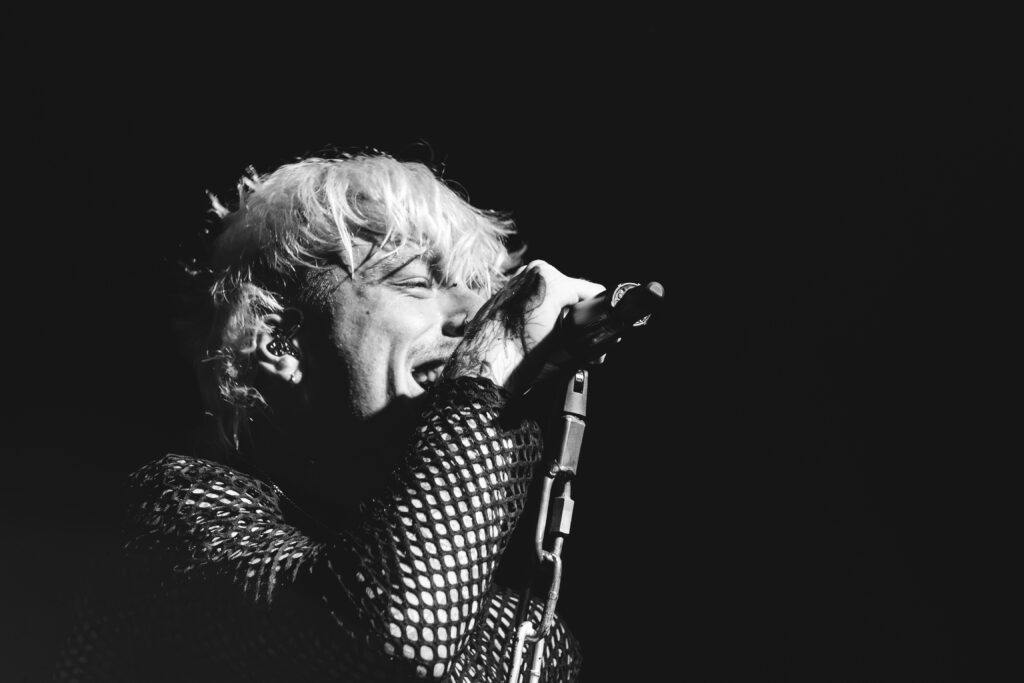
EN
What are the biggest challenges you face as a concert and documentary photographer?
The first one? Definitely the lack of fair pay. People often forget that photography is real work, it takes time, skill, and serious commitment. A lot of folks assume that because we love what we do, we should do it for free. That’s just not how it works. Then there’s something I still face way too often: being a woman in a male-dominated industry. It’s way too easy for people to label us as “groupies” just because we’re backstage or close to the artists. That kind of judgment weighs on you, and it means constantly having to prove that you’re there to work, that you belong. But it’s not just about me as a photographer, it’s a much bigger issue. Singers, musicians, sound techs, so many women in this scene have to work twice as hard just to be taken seriously. There’s still a long way to go to shift those mindsets.
Do you have a standout story or memory from a shoot or a concert you’ve covered?
There are honestly so many… but one of the most special memories for me was when my 4-year-old son came to his very first concert. He grabbed his little toy camera and started taking pictures with stars in his eyes. It was really moving to watch him capture the moment in his own way, and through him, I got to relive the raw emotion of my early days behind the lens. That said, I don’t really have one standout story, because every show, every artist brings something different. That’s the beauty of it.
What are your goals with this Just Human exhibition? Do you plan to take it to other venues or festivals?
Right now, I’m fully focused on this first exhibition. My main goal is to make sure it truly honors the artists it highlights, that it does them justice. If it ends up traveling or reaching new audiences down the line, that would be amazing… but first, I want to get this one exactly right.
Do you have any other projects in the works outside of this exhibition?
No, and that’s intentional. Just Human is a project that means a lot to me, and I want to give it everything I’ve got. I’m all in. Every detail matters to me, and this project deserves my full attention.
What advice would you give to young photographers who want to break into music or documentary photography?
Be patient, be passionate… and most importantly, stay true to yourself. Photography isn’t just about technique, it’s about perspective, emotion, and how you feel what you’re capturing. Don’t try to copy someone else’s style. Find your own way of telling stories, your own voice, your own rhythm. And hang in there. This industry can be tough, but every moment you capture has value. Don’t let anyone make you question your place. Your sensitivity is your superpower.
FR
Quelles sont les plus grandes difficultés que tu rencontres en tant que photographe de concerts et de reportages ?
La première difficulté, c’est le manque de rémunération. On oublie trop souvent que la photo est un vrai métier, qui demande du temps, des compétences et de l’investissement. Beaucoup pensent que parce qu’on aime ce qu’on fait, on devrait le faire gratuitement.. faux! Et puis, il y a une réalité encore trop présente : celle d’être une femme dans un univers encore très masculin. On nous colle facilement l’étiquette de « groupie », simplement parce qu’on est là, en backstage ou proches des artistes. Ce regard-là est pesant, et il faut sans cesse prouver qu’on est là pour travailler, qu’on est légitimes. Mais ce n’est pas juste un problème qui me concerne en tant que photographe : c’est un souci bien plus large. Les chanteuses, les musiciennes, les techniciennes… toutes doivent souvent travailler deux fois plus pour être prises au sérieux et prouver qu’elles méritent leur place. Il y a encore beaucoup à faire pour faire évoluer les mentalités.
As-tu une anecdote marquante à partager sur un shooting ou un concert que tu as couvert ?
Il y en aurait plein… mais l’un des souvenirs les plus forts pour moi, un concert que j’ai couvert. Le jour où mon fils de 4 ans a assisté à son tout premier concert. Il a spontanément pris son petit appareil photo et s’est mis à photographier, avec des étoiles plein les yeux. C’était touchant de le voir capturer à sa manière ce que je vis depuis des années. À travers lui, j’ai revécu toute l’émotion brute de mes débuts. Mais sinon, je n’ai pas une anecdote unique qui se détache, parce qu’au fond, chaque concert, chaque artiste est différent.
Quels sont tes objectifs avec cette exposition “Just Human” ? Comptes-tu l’emmener dans plusieurs lieux ou festivals ?
Pour l’instant, je me concentre à fond sur cette première exposition. Mon objectif, c’est qu’elle soit à la hauteur des artistes qu’elle met en lumière, qu’elle leur rende vraiment hommage. Je me dis que si elle peut ensuite voyager, toucher d’autres publics, pourquoi pas…
As-tu d’autres projets en préparation en dehors de cette exposition ?
Non, parce que c’est un projet que je porte à coeur, et j’ai envie de le faire bien, sans rien laisser au hasard. Je préfère me concentrer à fond sur “Just Human”. Pour moi, chaque détail compte, et ce projet mérite toute mon attention.
Quel conseil donnerais-tu aux jeunes photographes qui souhaitent se lancer dans la photographie musicale et documentaire ?
Soyez patients, passionnés… et surtout, restez vous-mêmes. La photo, ce n’est pas juste une question de technique, c’est avant tout une affaire de regard, de ressenti, d’émotion. Ne cherchez pas à imiter les autres, trouvez votre propre manière de raconter ce que vous voyez, ce que vous vivez. Et surtout, accrochez-vous. Ce milieu peut être dur, mais chaque instant que vous capturez a de la valeur. Ne laissez personne vous faire douter de votre place. Votre sensibilité est une force.
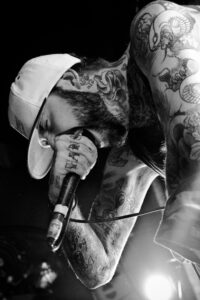
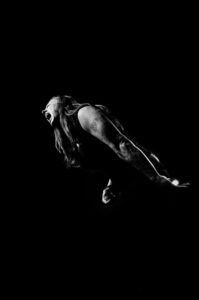
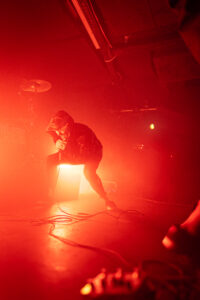
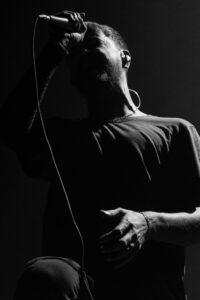
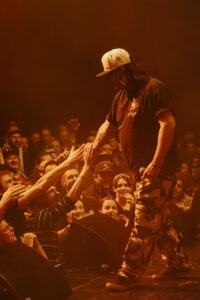
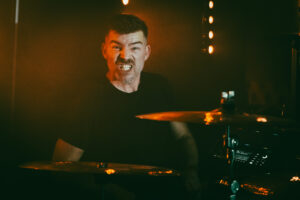
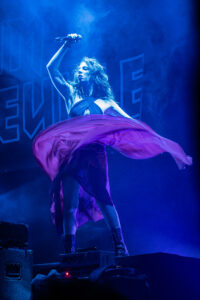
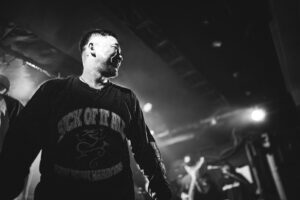
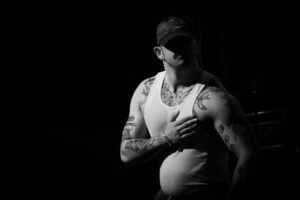
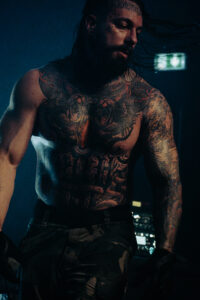
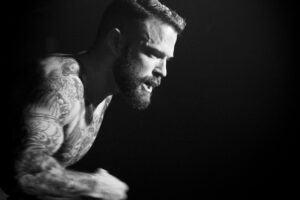
Naturally, every photo featured in this article is a piece by Angelle.
Évidemment, chaque photo présentée dans cet article est une œuvre d’Angelle.
Explore our latest interviews !
Découvrez nos derniers interviews !


